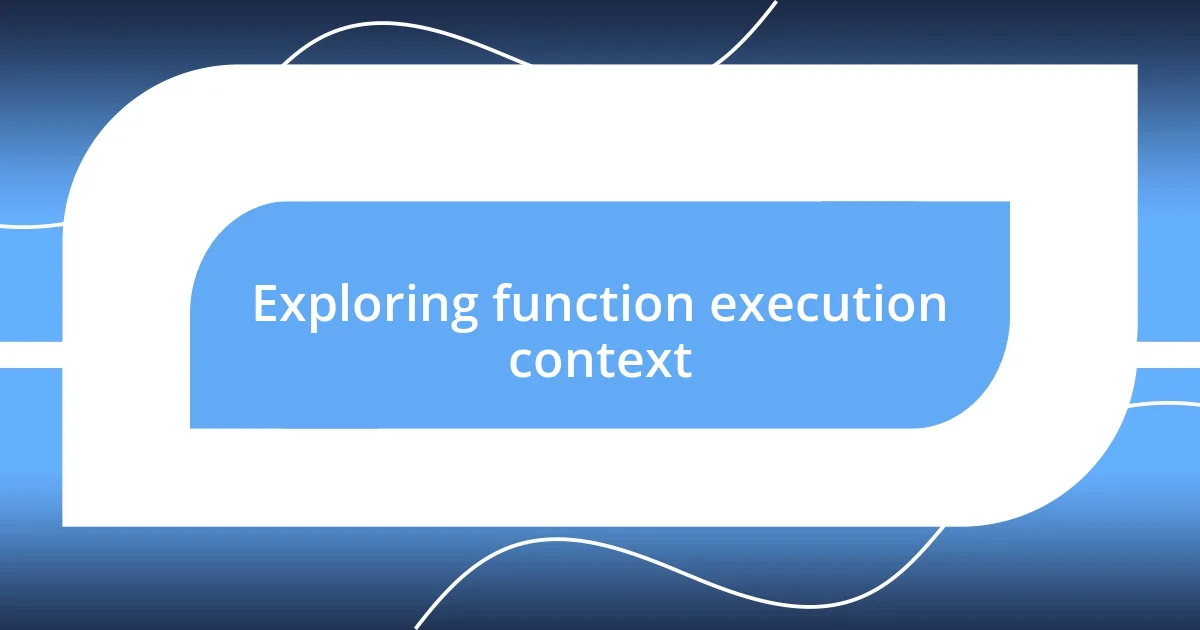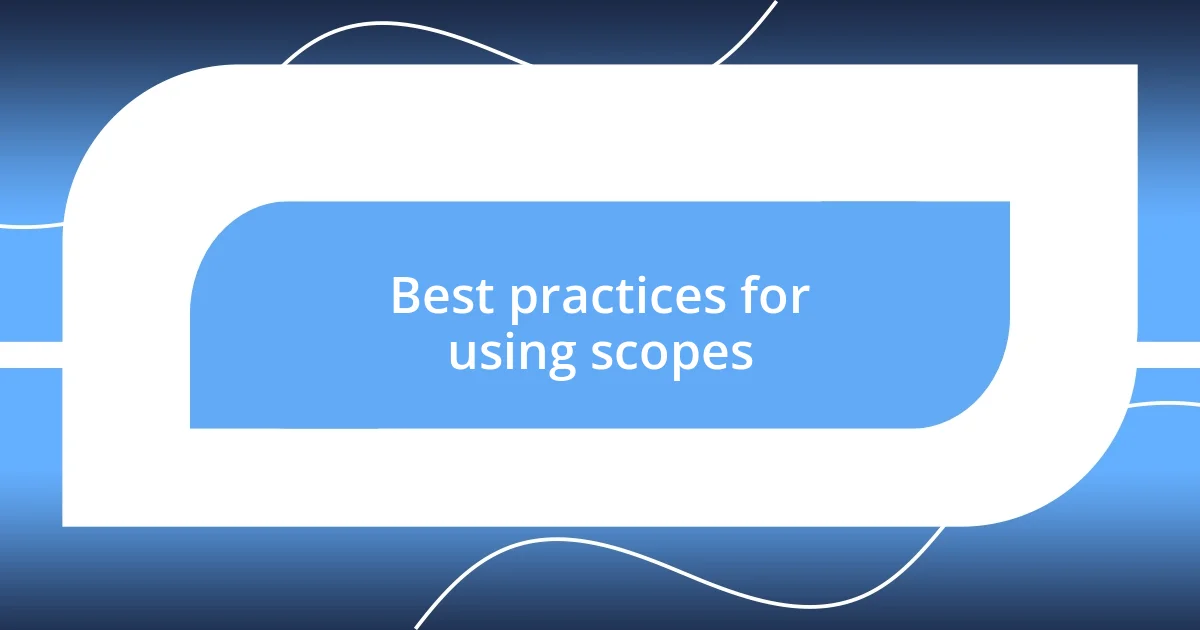Key takeaways:
- Closures enable functions to retain access to variables in their lexical scope, assisting in state management without polluting the global namespace.
- Understanding lexical scope simplifies coding by defining variable visibility, ensuring cleaner and more organized code while minimizing errors.
- Using closures effectively can optimize performance, reduce redundancy, and enhance the clarity of asynchronous code management.

Understanding closures in programming
When I first encountered closures in programming, it felt like unveiling a hidden layer of functionality within functions. Essentially, a closure is a function that retains access to its lexical scope, even when that function is executed outside of its original scope. It amazed me how this concept allows for the creation of private variables, which made my coding cleaner and more organized.
I remember a moment when I was stuck trying to manage state in a JavaScript application. That’s when I discovered how closures could encapsulate variables, allowing them to persist across function calls. It was like unlocking a secret passageway in a familiar building; I suddenly had a new way to control my data without cluttering the global namespace.
Think about it: how often do you find yourself needing to manage complex interactions between functions? With closures, the ability to maintain a state without exposing it to the global context not only simplifies your code, but it also enhances security and reduces potential bugs. This realization changed the way I approached function design entirely, emphasizing the need for thinking about scope and lifecycle in every project I undertake.

Defining lexical scope clearly
Lexical scope is one of those foundational concepts that, once understood, can significantly change how you write your code. It essentially refers to the visibility of variables within specific parts of your code based on where they are declared. I clearly remember the sense of clarity I felt when I finally wrapped my head around it: variables defined inside a function are not accessible from the outside, which made me rethink how I structured my code to avoid unintended variable clashes.
Here’s a concise breakdown of lexical scope:
- Function Context: Variables declared within a function are local to that function.
- Nested Functions: Inner functions have access to the variables of their outer functions, creating a chain of visibility.
- Global Scope: Outside of any function, variables are accessible globally unless they are shadowed by local variables.
Understanding lexical scope not only improved my coding practices but also gave me the confidence to build more structured and organized applications. It felt empowering to know that by utilizing scope effectively, I could minimize errors and make my code easier to read and maintain.

Exploring function execution context
Exploring how functions execute within their context has always fascinated me. I remember grappling with the concept of “execution context” when I first started coding in JavaScript. It dawned on me that every time a function is invoked, it creates a new execution context, which includes its variables, the value of this, and the parent scope. It felt like each function had its own little world, and understanding this built a strong foundation for both my coding skills and the way I approached problem-solving.
One of the biggest eye-openers during my coding journey was realizing how closures work within different execution contexts. Take a moment to reflect: when a function returns another function, it doesn’t lose its connection to the outer function’s scope. This means that even after the outer function exits, the inner function still “remembers” its environment. It’s a bit like a musician who continues to play even when the concert hall is empty, enriching the experience of potential future listeners by carrying forward the melody.
The concept of execution context completely shifted my perspective on variable management. I can vividly recall a time when I unintentionally introduced a bug due to misunderstanding how contexts persist. That was a turning point for me, as I started to embrace this concept diligently in my coding practices. It taught me that by having a solid grasp of execution contexts, I could predict and control errors much better, making debugging a less daunting task.
| Concept | Description |
|---|---|
| Execution Context | A context that is created whenever a function is called, containing the function’s scope, its variables, and the value of this. |
| Closure | A function that retains access to its lexical scope even when executed outside of its original environment, allowing for state management between function calls. |

Analyzing closure use cases
Analyzing closure use cases reveals not only their practicality but also their elegance in coding. One memorable instance from my journey was when I implemented a closure to manage state in a simple counter application. By leveraging closures, I could create a function that retained its state between calls, which made my code not just cleaner, but also far more intuitive. Have you ever realized how elegantly such a concept can transform a messy piece of code into a streamlined function?
I recall a phase when I experimented with event handling in a JavaScript application. Using closures allowed me to associate specific data with each event listener without polluting the global scope. The thrill of seeing my functions maintaining a connection to their variables, even as I clicked buttons to trigger events, was riveting. It felt like I was mastering a kind of magic; the ability to create private data that wasn’t accessible to the outside world but could still be influenced by a user’s actions. Isn’t it fascinating how closures create a secure environment for managing data?
Another use case that stands out is the implementation of a memoization technique. When tackling complex problems, caching results through closures became my go-to method to enhance performance. It was so satisfying to see how drastically it improved the speed of recursive functions. I often found myself pondering how much more robust my solutions could be if I consistently utilized closures for efficient state management. Have you tried applying closures in your own projects to see the impact they can have? The difference can be striking!

Common pitfalls with closures
Diving deep into closures, one common pitfall I’ve encountered is the tendency to confuse them with unrelated contexts. It’s easy to think that, because a closure appears to have access to outer variables, you can freely manipulate them without consequence. I once made this mistake by unintentionally altering a variable in a parent scope, which led to unexpected behavior in my code. Have you ever been caught in that trap? It’s disheartening when the solution lies in something that feels so trivial.
Another challenge I often see is the potential for memory leaks due to closures holding onto references longer than necessary. I vividly recall a project where I created closures in a loop that retained references to DOM elements. This oversight led to a performance hit that was difficult to track down. It felt like a haunting shadow over my smooth-running application. A simple adjustment, like nullifying references after use, could have saved me a lot of headaches. It’s a reminder that being mindful of resource management is just as critical as the functionality we’re trying to achieve.
Finally, there’s the issue of debugging with closures – it can be incredibly tricky. I remember feeling a rush of frustration when I couldn’t pinpoint why my inner function wasn’t returning the expected values. In those moments, I’d often find that a lack of clear variable naming or excessive nesting obscured my path to a solution. Have you experienced the same confusion? It’s essential to keep closures clean and straightforward, both for your own understanding and for anyone else who might encounter your code later. Simplicity really does foster clarity, and I strive to embody this principle in all my coding practices.

Optimizing performance with closures
Optimizing performance with closures can be a game changer in your coding toolkit. I remember when I first grasped that closures could help eliminate redundant calculations by retaining function states. It felt like lifting a fog; the speed boost from caching results enabled me to focus on more complex logic without sacrificing efficiency. Have you ever realized how effortless your code can become when it maintains context automatically?
When crafting a dynamic UI, I discovered the tremendous benefits of closures in JavaScript event handling. By creating functions that preserved specific data for each listener, I avoided unnecessary data reassignments and heavy lifting during user interactions. There’s something truly satisfying about seeing a responsive application thrive, all thanks to closures efficiently managing scope. It’s as if my code developed a personality, reacting to users with fluidity and grace.
I’ve also found that using closures facilitates clear separation of concerns, especially when dealing with asynchronous operations. The first time I implemented a closure to manage a series of callbacks, it was like a light bulb went off. Rather than juggling multiple variables, I streamlined my code into concise chunks. It not only improved readability but also made debugging a breeze. Have you ever tried organizing your async tasks this way? The clarity it brings can really enhance your development flow.

Best practices for using scopes
Using scopes effectively is all about maintaining clarity and organization in your code. I’ve experienced the frustration of working with deeply nested functions that made it difficult to track where each variable was defined. Simplifying scope by utilizing named functions instead of anonymous ones helped me shine a light on my intentions, making it far easier to debug. Have you ever found yourself lost in a tangle of code, only to realize a simple naming convention could have guided you back?
Another best practice I hold dear is being intentional with variable declarations. I distinctly recall a project where I used let and const strategically, ensuring that block scope was respected and reducing unintended side effects. This discipline not only promoted immutability where appropriate but also made my code more predictable. Have you noticed how much smoother your development process feels when you commit to this practice?
It’s also crucial to remember to clear out any unused closures to free memory and prevent old references from sticking around. I once led a team that overlooked this detail, which gradually slowed down our application. By implementing a routine to assess and tidy our closures, we noticed a substantial boost in performance. Isn’t it enlightening how something as simple as clear-out strategies can dramatically enhance efficiency?














